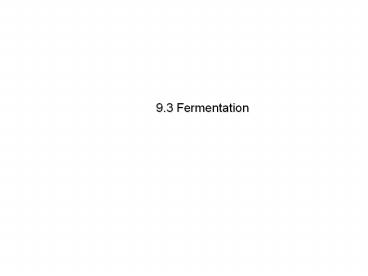9.3 Fermentation - PowerPoint PPT Presentation
Title:
9.3 Fermentation
Description:
9.3 Fermentation Fermentation Fermentation is a process by which energy can be released from food molecules in the absence of oxygen. Fermentation occurs in the ... – PowerPoint PPT presentation
Number of Views:300
Avg rating:3.0/5.0
Title: 9.3 Fermentation
1
- 9.3 Fermentation
2
Fermentation
- Fermentation is a process by which energy can be
released from food molecules in the absence of
oxygen. Fermentation occurs in the cytoplasm of
cells.
3
Fermentation
- Under anaerobic conditions, fermentation follows
glycolysis. During fermentation, cells convert
NADH produced by glycolysis back into the
electron carrier NAD, which allows glycolysis to
continue producing ATP.
4
Alcoholic Fermentation
- Yeast and a few other microorganisms use
alcoholic fermentation that produces ethyl
alcohol and carbon dioxide. - This process is used to produce alcoholic
beverages and causes bread dough to rise.
5
Alcoholic Fermentation
- Chemical equation
- Pyruvic acid NADH ? Alcohol CO2 NAD
6
Lactic Acid Fermentation
- Most organisms, including humans, carry out
fermentation using a chemical reaction that
converts pyruvic acid to lactic acid. - Chemical equation
- Pyruvic acid NADH ? Lactic acid NAD
7
Energy and Exercise
- How does the body produce ATP during different
stages of exercise? - For short, quick bursts of energy, the body uses
ATP already in muscles as - well as ATP made by lactic acid fermentation.
- For exercise longer than about 90 seconds,
cellular respiration is the only - way to continue generating a supply of ATP.
8
Quick Energy
- Cells normally contain small amounts of ATP
produced during cellular respiration, enough for
a few seconds of intense activity. - Lactic acid fermentation can supply enough ATP
to last about 90 seconds. However, extra oxygen
is required to get rid of the lactic acid
produced. Following intense exercise, a person
will huff and puff for several minutes in order
to pay back the built-up oxygen debt and clear
the lactic acid from the body.
9
Long-Term Energy
- For intense exercise lasting longer than 90
seconds, cellular respiration is required to
continue production of ATP. - Cellular respiration releases energy more slowly
than fermentation does. - The body stores energy in the form of the
carbohydrate glycogen. These glycogen stores are
enough to last for 15 to 20 minutes of activity.
After that, the body begins to break down other
stored molecules, including fats, for energy.
10
Long-Term Energy
- Hibernating animals like this brown bear rely on
stored fat for energy when they sleep through the
winter.

